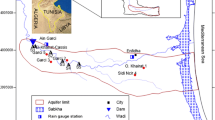Abstract
The government of Egypt has decided to construct a new barrage with hydropower facilities, 3.5 km downstream of the existing old one. The water levels in the head pond for the new barrage will be continuously maintained at a level with approximately 0.5 m higher than water level in the head pond of the existing one. To evaluate the effect of increasing the head pond water level on the groundwater and drainage, there is a need to enhancelinking reservoir and stream/aquifer system. Visual MODFLOW hasbeen used to simulate the surface water/groundwater interaction in the area of proposed new barrage. The model has been calibratedagainst the available historical groundwater levels for 25 observation wells based on the steady state conditions. Numerical modeling suggests that river stage is the primary control of rapid groundwater hydraulic head fluctuations in theaquifer system. At present the area at which the depth to groundwater table less than one meter is about 30 110 feddans (1 feddan = 4200 m2). This area will increase to be about40 610 feddans after the construction of the new barrage and increasing the head pond water level. The mitigation measures toovercome the effect of construction of the new barrage have been discussed and their costs have been estimated and evaluated. Increasing the efficiency of existing drainage system by maintenance/upgrading and constructing a new pump station is recommended.
Similar content being viewed by others
References
Abdallah, A. M., Korany, E. A. and Abd El Mageed, E. M.: 1999, ‘Hydrogeologic investigation on Beni Suef area, Nile Valley, Egypt’, J. Sedimitilogical Society of Egypt 7.
Abu Zeid, M.: 1985, ‘Irrigation in Egypt – Present and Future’, Eighth Seminar of the Regional Commission on Land and Water Use, Cyprus, FAO, Rome.
Attia, F. A. R.: 1985, ‘Management of Water Systems in Upper Egypt’, Ph.D. Thesis, Faculty of Engineering, Cairo, University, Cairo, Egypt.
Belaineh, G., Peralta, R. C. and Hughes, T. C.: 1999, ‘Simulation/optimization modeling for water resources management’, J. Water Resour. Plann. Manage., ASCE, 125(3).
Dawoud, M. A.: 2001, ‘Environmental and Economical Impacts of Groundwater Rise on Egyptian Rural Development’, Proceedings of the Third Conference of Egyptian Rural Development, Menoufia University, Egypt.
Dawoud, M. A.: 1997, ‘Numerical Simulation for Groundwater Conditions in West Tahta Area’, M.Sc. Thesis, Ain Shams University, Faculty of Engineering, Irrigation and Hydraulics Department, Egypt.
EPADP (Egyptian Public Authority for Drainage Projects) and KFW: 1998, ‘Improvement of Drainage Situation Upstream of the New Nag Hammadi Barrage’, Main Reporr, Volume 1.
Gasser, M. M.: 1996, Impact of High Aswan Dam on Egypt, Issues and Directions in Hydraulics, pp. 377–417.
Goodwin, P. and Falte, M.: 2002, ‘Managing for Unforeseen Consequences of Large Dam Operations’, Paper prepared for Thematic Review, IV.5: Operation, Monitoring and Decommissioning of Dams.
Gundelach, J. and Revelle, C.: 1975, 'Linear decision rule in reservoir management and design: A general algorithm, Water Resour. Res. 11(6).
Hellay, A. M.: 2002, ‘Use of Vertical Electrical Sounding in Determining Some Aquifer Characteristics’, GSA Joint Annual Meeting, Lexington, Kentucky, U.S.A.
Jenkins, C. T.: 1968, ‘Techniques for computing rate and volume of stream depletion by wells’, Groundwater 66(2).
Loucks, D. P. and Dorfman, P.: 1975, ‘An evaluation of some linear decision rules in chance constrained models for reservoir planning and operation’, Water Resour. Res. 11(6).
Morel-Seytoux, H. J. and Daly, C. J.: 1975, ‘A discrete kernel generator for a stream aquifer studies’, Water Resour. Res. 11(2).
Morel-Seytoux, H. J., Peters, G., Young, R. and Illangasekare, T.: 1980, ‘Groundwater Modeling for Management’, Proceedings of International Symposium on Water Resources System, Water Resources Division Training Center, University of Roorkee, Roorkee, India.
Morel-Seytoux, H. J., Restrepo, J. I. and Rathnayake, R. M. D.: 1985, ‘SAMSON, Executive Summary, Description of SAMSON Computer System, General Flow Chart, Flow Chart for Twelve Basic Blocks and Subroutine Documentation’, Report No. 85.5, HYDROWAR Reports Div., Hydro. Days Publications, Dept. Civ. Engrg., Colorado State University, Fort Collins, Colorado, U.S.A.
Nield, S. P., Townley, L. R. and Barr, A. D.: 1994, ‘A framework for quantitative analysis of surface water–groundwater interaction: Flow geometry in a vertical section’, Water Resour. Res. 30(8), 2461–2475.
Peralta, R. C., Gharbi, A., Willardson, L. S. and Peralta, A. W.: 1990, ‘Optimal Conjunctive Use of Groundwater and Surface Water’, in G. G. Hoffman, T. A. Howell and K. H. Solomon (eds), Management of Farm Irrigation Systems, ASEA, St. Joseph, Mich., pp. 427–458.
RIGW: 1991, The Hydrogeological Map of Nile Valley, scale 1:100,000, Nag Hammadi and Qena Mapsheets, Technical Notes.
Warner, J. W., Gates, T. G., Attia, F. A. R. and Mankarious, W. F.: 1991, ‘Vertical leakage in Egypt's Nile Valley: Estimation and implications’, J. Irrig. Drainage Engineer., ASCE, 117(4), 515–533.
Author information
Authors and Affiliations
Corresponding author
Rights and permissions
About this article
Cite this article
Dawoud, M.A., Allam, A.R. Effect of New Nag Hammadi Barrage on Groundwater and Drainage Conditions and Suggestion of Mitigation Measures. Water Resources Management 18, 321–337 (2004). https://doi.org/10.1023/B:WARM.0000048484.39933.9e
Issue Date:
DOI: https://doi.org/10.1023/B:WARM.0000048484.39933.9e




